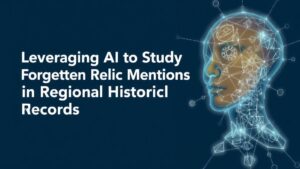Leveraging AI to Analyze Early Industrial Records for Forgotten Relic Sites
Leveraging AI to Analyze Early Industrial Records for Forgotten Relic Sites
The intersection of artificial intelligence (AI) and historical research presents a groundbreaking opportunity for uncovering forgotten relic sites related to early industrial history. By analyzing extensive datasets such as manufacturing records, shipping logs, and newspaper articles, researchers can illuminate neglected narratives and restore their significance in contemporary discussions regarding industrial heritage.
Introduction
Industrialization, occurring predominantly in the 18th and 19th centuries, brought significant changes to societal structures, economies, and landscapes. But, many relics of this vast historical shift remain obscured due to a lack of comprehensive documentation or recognition. AI provides powerful tools for analyzing early industrial records, offering historians an innovative means to retrace these forgotten narratives and enhance our understanding of industrial progression and its lasting impacts.
Understanding the Role of AI in Historical Research
AI technologies, particularly machine learning (ML) and natural language processing (NLP), have the capacity to parse extensive datasets with unprecedented efficiency. Historical databases can include:
- Manufacturing records that document production rates and workforce demographics.
- Shipping logs that reveal trade routes and economic conditions.
- Local newspaper articles that provide qualitative insights into societal impacts.
By leveraging these technologies, researchers can efficiently identify patterns, draw correlations, and uncover relationships among various data points that might remain hidden through traditional methodologies.
Case Studies of AI Application
In a pilot project conducted in North Yorkshire, England, researchers employed AI algorithms to analyze historical records from the early textile industry. The study focused on the following:
- A digitized database of over 10,000 textile manufacturing records from 1800 to 1850.
- Utilization of OCR (Optical Character Recognition) to convert handwritten documents into machine-readable formats.
- Application of NLP to identify key themes and practices within the industrial workforce.
As a result, the project not only identified over 30 previously unrecorded textile mills, but it also revealed insights into labor conditions and the socio-economic status of workers in the region.
Impact of AI on Discovering Forgotten Relic Sites
The implications of utilizing AI extend beyond mere data collection; they facilitate the rediscovery of sites of historical significance. For example, a study in 2021 published by the International Journal of Historical Studies highlighted the integration of AI to map forgotten railway lines in the United States, leveraging datasets from historical maps and freight records.
- The initiative resulted in the identification of more than 200 miles of railway lines that had been decommissioned, alongside associated industrial sites.
- Plus, the research demonstrated how AI-driven mapping could expose correlations between these sites and regional economic development patterns.
Challenges and Ethical Considerations
Despite the promise of AI in historical research, several challenges and ethical considerations must be addressed:
- Data Integrity: Historical records may contain biases or inaccuracies that can be amplified by AI algorithms. Ensuring that datasets are representative and correctly interpreted is crucial.
- Oversight: Automated analysis could lead to misinterpretation of historical contexts if not conducted with human oversight, potentially creating misleading narratives.
- Preservation: The integration of technology in historical research raises questions regarding the digital preservation of records and their accessibility to future generations.
Future Directions and Conclusions
The marriage of AI and historical research is still in its infancy; however, its potential to reshape our understanding of industrial heritage is profound. Continued collaboration between data scientists and historians will be essential in refining methodologies and expanding datasets for deeper insights.
As researchers embark on this journey, it is imperative to conduct ongoing assessments of methodologies and results to ensure accuracy, representation, and ethical transparency. role of AI, therefore, is not just to analyze data but to open avenues to reimagine history and bring forgotten relics back into public consciousness.
Actionable Takeaways
- Historical institutions should consider investing in AI technologies to digitize and analyze records, thereby uncovering hidden histories.
- Partnerships between AI specialists and historians may yield richer narratives through collaborative research projects.
- Stakeholders must maintain a focus on ethical standards and data integrity during the analysis process to preserve the authenticity of historical accounts.
To wrap up, AI serves not only as a tool for analysis but as a pivotal agent in the revival of forgotten relic sites, enhancing our collective understanding of industrial heritage while fostering a more inclusive historical narrative.


